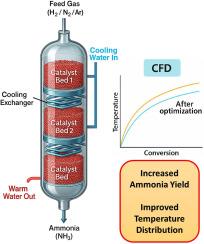提高氨反应器效率:内部冷却换热器的数值模拟与优化
IF 3.9
3区 工程技术
Q3 ENERGY & FUELS
Chemical Engineering and Processing - Process Intensification
Pub Date : 2025-08-07
DOI:10.1016/j.cep.2025.110498
引用次数: 0
摘要
本研究提出了一个全面的建模和优化框架,通过集成内部中间冷却交换器(IICE)来提高工业规模氨合成反应器的性能,这在以前没有在实际工业环境中建模或优化。以设拉子石化综合装置为研究对象,分别利用MATLAB和COMSOL建立了一维(径向)和二维(径向-轴向)反应器模型,求解了实际工况下的质量、能量和动量守恒方程。针对工厂数据的模型验证证明了极好的一致性,证实了所提出模型的准确性。为了提高反应器的性能,采用差分进化算法对反应器入口温度、压力和进料流量等关键运行参数进行优化。优化条件(463.9 K, 169.99 bar, 292,476 kg/h kg/h)使氨摩尔分数比当前操作增加16.2%,达到最大值0.21。这项工作的新颖之处在于在多床配置中对IICEs进行系统集成和评估,这在以前的文献中没有得到验证。本文还对潜在的经济影响进行了评估,表明将内部热回收与数值优化相结合可以提高工业反应器的氨合成和降低能耗。本文章由计算机程序翻译,如有差异,请以英文原文为准。

Enhancing ammonia reactor efficiency: Numerical modeling and optimization with internal cooling exchanger
This study presents a comprehensive modeling and optimization framework for enhancing the performance of an industrial-scale ammonia synthesis reactor through the integration of internal intermediate cooling exchangers (IICE), which has not been previously modeled or optimized in a real industrial context. Focusing on the Shiraz Petrochemical Complex, both one-dimensional (radial) and two-dimensional (radial–axial) reactor models were developed using MATLAB and COMSOL, respectively, to solve the mass, energy, and momentum conservation equations under realistic operating conditions. Model validation against plant data demonstrated excellent agreement, confirming the accuracy of the proposed models. To improve reactor performance, a Differential Evolution (DE) algorithm was applied to optimize key operating parameters namely reactor inlet temperature, pressure, and feed flow rate. The optimized conditions (463.9 K, 169.99 bar, and 292,476 kg/h kg/h) led to a 16.2 % increase in ammonia molar fraction compared to current operation, achieving a maximum value of 0.21. The novelty of this work lies in the systematic integration and assessment of IICEs in a multi-bed configuration, previously unvalidated in literature. It also evaluates potential economic impacts, demonstrating that coupling internal heat recovery with numerical optimization can enhance ammonia synthesis and lower energy consumption in industrial reactors.
求助全文
通过发布文献求助,成功后即可免费获取论文全文。
去求助
来源期刊
CiteScore
7.80
自引率
9.30%
发文量
408
审稿时长
49 days
期刊介绍:
Chemical Engineering and Processing: Process Intensification is intended for practicing researchers in industry and academia, working in the field of Process Engineering and related to the subject of Process Intensification.Articles published in the Journal demonstrate how novel discoveries, developments and theories in the field of Process Engineering and in particular Process Intensification may be used for analysis and design of innovative equipment and processing methods with substantially improved sustainability, efficiency and environmental performance.

 求助内容:
求助内容: 应助结果提醒方式:
应助结果提醒方式:


